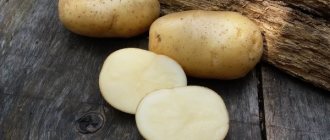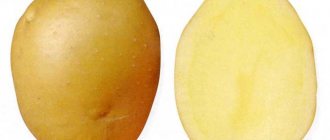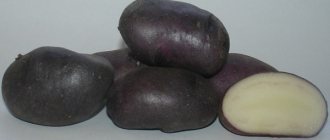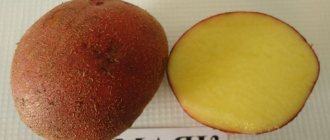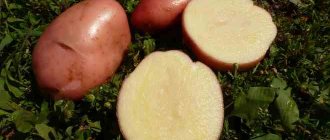Description of the potato variety Mozart
The Mozart potato was developed in Holland in the mid-2000s. by HZPC specialists. A few years later, it was successfully tested in Russia - in 2010 it was included in the register of breeding achievements. Potatoes are not too demanding on care and climatic conditions, so they can be cultivated in all regions of the European part of the country:
- in North-west;
- in the Moscow region and the middle zone;
- in the Volga-Vyatka region;
- in the Black Earth Region;
- in the North Caucasus and other southern regions.
Main characteristics of the Mozart potato:
- table (mass fraction of starch from 14.5% to 17%);
- medium-late (tubers are formed in 80-110 days);
- medium or tall (up to 70-80 cm);
- plant of intermediate type.
The bush is not spreading - erect or semi-erect. The leaves are medium sized, green, type – intermediate or open. The color of the leaf blade is slightly wavy, the corollas are quite large, red-violet in color.
The tubers are oval in shape and can also be rounded-oval. They are large in size - average weight 100-140 g, diameter 4-5 cm. The peel is red, the surface is smooth or slightly rough, the eyes are shallow and therefore hardly noticeable. The pulp is yellow when cut, holds its shape quite well - the degree of boiliness is moderate. Taste qualities according to the register of breeding achievements are characterized as “good” and “excellent”.
Important! The commercial yield of Mozart potato tubers ranges from 86% to 98%. This is a fairly high figure, which makes it possible to grow the crop both for personal consumption and for sale.
Potatoes Mozart have a very pleasant taste
Manufacturer, calorie content, composition
The famous chocolate liqueur is produced in the Austrian city of Salzburg, exactly where the brilliant composer was born. Despite the fact that the Mozart Distillerie is considered a family business, it is not distinguished by conservatism and offers its consumers unique alcoholic drinks that will not leave anyone indifferent.
There is a beautiful legend that the music of the great composer is used to prepare liqueur. The thing is that ultrasound is used to grind chocolate and turn it into a liquid state. The basis for extracting these sounds are the works of the great master.
Mozart liqueur contains only natural ingredients of the highest quality, namely:
- bourbon vanilla;
- Belgian chocolate;
- rare varieties of cocoa.
Article on the topic: Potato variety “Akrosiya” - description and photo
In addition, the list of ingredients includes ethyl alcohol produced from sugar cane. It has a high degree of purification and is considered the best basis for the production of this unique drink. The 3 main types of liqueur have an ABV of 15-17 percent, and only Mozart Dry has an ABV of 40 percent. In addition, it contains absolutely no sugar.
This amazing drink is used both in its pure form and for preparing various cocktails. In terms of its chemical composition, it is rich in vitamins and also contains various useful microelements. The calorie content of the liqueur is 332 kcal per 100 ml.
Characteristics of the Mozart potato variety
Mozart potatoes have poor frost resistance - in fact, they cannot withstand prolonged frosts, so it is better to plant the tubers closer to mid-May. At the same time, the variety tolerates freezing well. The skin of root crops is durable, which allows you to transport the crop over any distance. Keeping quality is also quite high - subject to storage conditions, the figure is 92%. Area of application: cooking, frying, stewing.
Productivity
Depending on the conditions of care and climate, Mozart potatoes ripen in 3-4 months after germination. 8-10 large tubers are harvested from 1 bush - the yield indicators are:
- 0.8-1.4 kg from 1 bush;
- 2.0-3.3 kg per 1 m2;
- 200-330 kg per 1 hundred square meters.
The maximum recorded yield of Mozart potatoes is 490 kg per 1 hectare. You can achieve impressive results by growing crops in fertile and light soil, as well as by following the basic rules of agricultural technology:
- regular watering during drought;
- thorough weeding and loosening of the soil;
- feeding - 3 times per season;
- hilling - at least 2 times;
- mowing the tops 2 weeks before harvesting.
Advantages and disadvantages
One of the main advantages of Mozart potatoes is their excellent taste and good presentation. The tubers are starchy, have a pleasant texture, and at the same time keep their shape. At the same time, the pulp does not darken even after heat treatment.
Mozart potato tubers have a regular round shape
pros
- excellent taste;
- good yield;
- drought resistance;
- can be grown in any region of Central Russia;
- good keeping quality and transportability;
- immunity to certain diseases;
- high commercial yield of root crops.
Minuses
- average resistance to late blight;
- late ripening;
- unstable to return frosts.
Reviews about the variety
Reviews about the taste and characteristics of growing the Mozart potato variety are very diverse. Almost everyone agrees that the taste of this variety is excellent, but its cultivation is more suitable for experienced gardeners. At the same time, gardeners notice that potato tubers, unlike many other varieties, are practically not susceptible to disease and are very resistant to mechanical damage, which, of course, sets Mozart apart from other potato varieties.
Potatoes "Mozart" are a unique variety that deserves the attention of every gardener.
Landing rules
Mozart potatoes begin to be planted in early May, and in the North-West - in the middle of the month. At this moment, the soil should have time to warm up to 10 degrees (can be measured by burying a thermometer for 10-15 minutes). Moreover, site preparation begins in the fall or, in extreme cases, in mid-April. The place for planting Mozart potatoes should be lighted and dry (not located in a low area). The optimal soil for it is sandy loam with a neutral or slightly acidic reaction.
Before planting, the field is thoroughly cleaned and dug up. If the soil is not too fertile, add up to 7 kg of humus or compost per m2. If the soil is clayey or heavy, be sure to add sand or sawdust at a rate of 500-800 g per 1 m2.
A month before planting, Mozart potato tubers are also prepared. They are transferred to a lighted and moderately warm room - the optimal temperature is 15-16 degrees. The seeds are sorted and dry and damaged ones are rejected. Then they are periodically sprayed with water, and on the day of planting they are treated with a fungicide - for example, Fitosporin, Prestige or Bordeaux mixture. It will also not be superfluous to spray the tubers with a growth stimulant - “Epin”, “Bioglobin” or others.
Planting Mozart potatoes is carried out according to the following algorithm:
- Manually or using a walk-behind tractor, form several furrows at intervals of 70-80 cm.
- Tubers are planted to a depth of 5-10 cm (the lighter the soil, the deeper).
- Leave 30-35 cm between adjacent holes.
- Sprinkle with wood ash.
- They are covered with soil; watering is not necessary - at first the plant will take moisture from the mother tuber.
Wood ash serves as a natural fertilizer and also protects Mozart potatoes from pests
Hilling and feeding
Selection and planting of seed are important stages in growing Mozart potatoes. But to get a high yield, you need to pay attention to the beds throughout the season.
Features of hilling
Experienced gardeners recommend hilling up Mozart potato beds twice per season. The bushes are treated for the first time when the stems grow to a height of approximately 20 cm. This procedure is repeated when the potato tops reach a height of 35-40 cm.
If the need arises, hilling is done more often. After all, this event significantly affects the yield of the Mozart variety. Thanks to hilling, the soil is loosened and the root crops receive air. The earthen beds allow additional tubers to set. Loosening the soil prevents it from drying out quickly, and at the same time removes weeds.
If the temperature is high, it is better to set aside time for the procedure in the morning and pre-moisten the potato beds.
How to fertilize
The Mozart potato variety is a mid-late variety, so it especially needs feeding during the period of green mass growth and tuber setting. It is most effective to use a local method of applying fertilizers. This way the nutrients will go directly to the root system.
In order not to make mistakes with the application of fertilizers and to get a good yield result, it is recommended to feed Mozart potatoes three times during the season:
- During active growing season, use a mixture of humus (15 glasses) and urea (10 tsp). This composition is sufficient to process a ten-meter row of potatoes.
- To stimulate the formation of buds and flowering of the Mozart variety, a combined composition is used: 30 tbsp. l wood ash is mixed with 10 tsp potassium sulfate. The dose is calculated for a bed 10 m long.
- To make tubers more active, use a solution of mineral fertilizers: dilute 2 tbsp in 10 liters of water. l superphosphate and potassium sulfate and 1 tbsp. l nitrophoska. Half a liter of fertilizer is poured under each bush.
It is not recommended to use organic matter during the flowering of Mozart potatoes, as this causes increased weed growth.
Features of cultivation
Potatoes Mozart are not very demanding to care for. But the better the conditions, the higher the yield. Therefore, the basic rules of agricultural technology should not be neglected:
- Watering - in hot weather: a bucket (10 l) for 2 bushes. The main criterion is the withering of the tops. Usually water is poured into the rows (special furrows need to be made between them).
- Hilling - after the bushes reach 20 cm, then 2 more times with an interval of 2-3 weeks. It is better to hill up in dry weather - it is especially convenient to do after recent rain.
- Loosening: first time a week after planting, then after heavy rains and watering (at least 2 times a month).
- Weeding is thorough, as necessary. To prevent weeds from interfering, Mozart potato plantings can be immediately mulched with sawdust or straw.
Rules of care
The “Mozart” variety, with the right agricultural technology, can surprise even experienced potato growers with a very high and high-quality harvest. To obtain high-quality vegetable products and minimize yield losses, you must follow the basic recommendations:
- The most intensive measures for caring for potato plantings are necessary for this vegetable crop in the initial stage of active growing season, when mechanical damage to the tops and root system does not have very negative consequences.
- Potato tops should be hilled twice. The first hilling is carried out when the plant height is 20 cm, and the second when the tops reach a height of approximately 35 cm. When cultivating potatoes on heavy soils and in waterlogged conditions, it is advisable to carry out at least two or three maximum deep hillings, the last of which should be performed before closing potato tops between rows
- Two days before harvesting, the row spacing should be loosened immediately after removing the potato tops.
Caring for potatoes after planting is simple, but only compliance with the mandatory rules, which include timely watering, weeding, fertilizing and preventive spraying, will help guarantee a good harvest.
Pests and diseases
Potato Mozart is resistant to nematode and cancer. It also has satisfactory immunity to late blight (but the risk of infection cannot be completely eliminated). Bushes can also suffer from other diseases and pests. Therefore, summer residents and farmers follow basic preventive measures:
- The rules of crop rotation are to change the potato field every 3-4 years.
- Do not plant in areas where tomatoes or potatoes of any kind have previously grown for a long time.
- Be sure to treat the tubers with a fungicide before planting.
- Periodically dust the bushes with wood ash.
- Carry out 1-2 treatments with fungicide and insecticide after the tops grow to 15-20 cm, or use folk remedies.
To prevent fungal diseases, effective drugs are used that protect Mozart potatoes well:
- "Fitosporin";
- "Prestige";
- "Quadris";
- "Profit";
- "Maksim";
- Bordeaux mixture.
Insecticides are used to control insects:
- "Fufanon";
- "Decis";
- "Colorado";
- "Medvetox";
- "Green Soap"
You can also use folk remedies - for example, treat Mozart potato bushes with a solution of wood ash with soap shavings, a decoction of marigolds, an infusion of garlic, and onion peels. It is advisable to fill the rows with fresh sawdust, and also water them 1-2 times per season with a weak tar mixture.
If a bush is affected by a disease, it must be quickly removed from other plantings, taken away and burned
Advantages and disadvantages
Pros:
- mid-early maturation;
- leveled and uniform harvest;
- excellent taste in different dishes;
- valuable pulp (many amino acids, vitamins, minerals);
- resistance to heat and drought;
- transportability without mechanical damage;
- resistance to a number of infections and parasites;
- the ability to use your own tubers as seed material for a long time;
- presentable appearance and marketability.
Minuses:
- need for protection from pests;
- risk of infection with late blight (during an epidemic in the area).
Harvesting and storage
When planting Mozart potatoes at the standard time (early May), the harvest begins in the first half of August. However, the harvesting time may extend until the beginning of September. The main condition is to have time to dig up the tubers in good, dry weather. The harvested crop is dried in the sun, sorted and put into bags.
Then they are sent for storage in a dark room. The first 2 weeks are maintained at a temperature of 14-15, then in the range of 2-4 degrees and a humidity of 70-80%. At the same time, they try to consume Mozart potato roots that are too large and small first.
Advice! If you mow the tops 1-2 weeks before harvest, the tubers will become larger.
Harvesting
After 15-20 days from the moment the plants bloom, the stems should be pressed to the ground. This is done so that less nutrients go into the stems and more remain in the roots. When the lower leaves turn yellow, the tops can be removed. In a week you can start digging potatoes.
In dry weather, it is advisable to leave the crop directly on the field to dry. In case of wet weather, it is better to spread the tubers under a shelter or indoors so that they continue to dry. In this case, potatoes must be sorted before storing them. Planting material is selected, diseased and sluggish tubers are thrown out. It is best to store potatoes in ventilated containers in a dark, dry and cool place.

